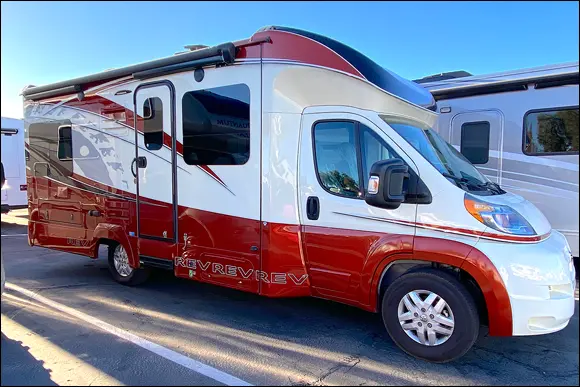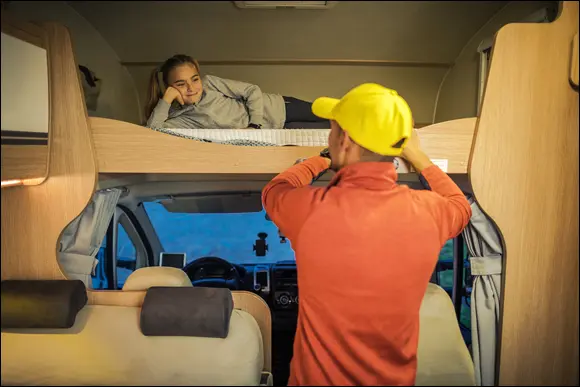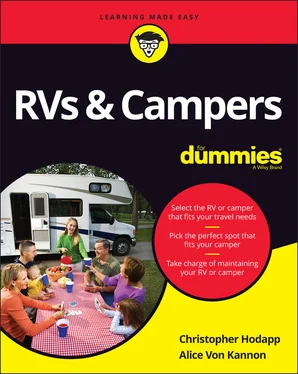Super Bs often have a slide-out section to get even roomier inside, and the rooflines on these bigger Bs can be higher, too. Most Class Bs have a pretty low ceiling, but Super Bs either start out as a taller cargo van or add a raised fiberglass roof. A high-end Class B+ like a Coach House has a singular appearance, much more like a streamlined Class C motorhome than a van, with a remarkable level of amenities for the size. A Super B like the Thor Compass may just as well be called a Class C, the boundary is so fuzzy.

Photograph courtesy of Christopher Hodapp
Speaking of bathrooms, Class Bs and some small travel trailers feature a wet bath to keep from having a separate space-hogging shower stall. A wet bath has a drain in the floor and a handheld shower head so that the entire bathroom becomes your shower stall. Although it saves lots of space, it means that all your People magazines, your toiletries bag, and anything else in the bathroom will get soaked. Depending on the arrangement, you may be standing right up against the toilet while you shower or even sitting on the toilet lid as you attempt to shave your legs.
The price range of Class Bs can be frustrating. Even though they’re much smaller than their Class A competition, they aren’t priced that way. Square foot for square foot, Class Bs are the most expensive of all RV types on the road. They commonly start at $90,000 and can go upwards of $200,000. Even used Class Bs tend to retain high resale value.
Class C motorhomes are the midsize option of motorized RVs: smaller than a Class A, but bigger than a Class B. They’re generally built on a truck frame from Chevrolet/GMC, Ford, or RAM, and the front ends commonly look like a medium-size delivery truck. Some of the biggest Super Cs (see the nearby sidebar) are built on a Ford F-550 or F-650 truck, or a Freightliner truck with a Cummins diesel engine.
Despite all the variations in size, the usual dead giveaway that you’re looking at a Class C is that there is an extended storage or sleeping area hump sprouting out over the top of the truck cab, while the rest of the body can be boxy (see Figure 2-4). The living area also often sits lower to the ground than it does in a big Class A, so you have no steep stairway to climb up when you go in and out the main door. Class Cs generally run between 21 and 45 feet long.
From a distance, Class Cs look like a big box of living space hung on the back end of an existing truck cab. In the business, this is called a cutaway frame, because it uses a truck or van front end, and cuts away the rest of the truck to add the RV box on the back. This setup permits the vehicle to utilize all the airbags, in-dash climate controls, and other safety systems built in by its original manufacturer. The front seats are fully open to the rest of the motorhome, so like the other types of motorhomes, passengers can get up and move around while you’re on the move.
Like the As and Bs, Class Cs are self-contained, with at least one bathroom, kitchen, dining area, and living space; they typically have a private bedroom with a queen-size bed as well. Class Cs are a good compromise when it comes to price, size, living space, and versatility. Many companies use slides to expand the interior living areas — usually widening the living and dining areas, and quite often enlarging the bedroom. Many smaller Cs only use a bedroom slide. As for storage, you’ll find plenty of both, inside and out.

Photograph courtesy of Christopher Hodapp
FIGURE 2-4:Class C motorhomes have a distinctive hump over the truck cab.
The common “cab-over” hump area in a Class C can make for some interesting spaces from one model to the next (see Figure 2-5). Some people use it as a sleeping nook, giving it a special sort of “upper bunk” or “tree fort” feel favored by kids, and most manufacturers provide a removable ladder to access it. Bigger, less-agile adults may find the cramped space to be a little too hard to crawl up into and way too claustrophobic to sleep in. Other campers use it as a raised, out-of-the-way storage shelf, often protected with a cargo net or doors to keep things from falling off when bouncing down the road. The area can be quite large, depending on the model, and it’s great for big, bulky items that don’t easily fit into storage cabinets. A few other models mount a large flat-screen TV and entertainment center over the opening, with access doors to get to the big empty space behind it.
You find a lot of variety in Class Cs. They may have outdoor bonuses like an exterior TV and speakers, or an outdoor cooking area with its own sink, fridge, stovetop, or microwave. Murphy beds that fold out of the wall are the new thing in the last few years, and both Class B and C motorhomes take full advantage of them. Because of their “big box on the back” design, some models convert the back end into a toy hauler (a sort of traveling garage with a ramp), which lets you bring motorcycles, ATVs, bikes for the whole family, canoes, kayaks, mobility chairs, or anything else you can pile in. Some of these let you reconfigure that backdoor ramp when you pull your toys out and make it a raised patio, with its own safety rails to keep the kids and the family dogs from falling off the back end. Some even have a second bathroom in the “garage,” so campers can use it without parading through your living room to get to the bigger family bathroom inside.

Virrage Images/Shutterstock
FIGURE 2-5:Kids love the upper bunk sleeping area in a Class C. It can also be used to store bulky items on the road.
Because they’re the middle children in the motorhome family, they usually cost a bit less to maintain than the giant Class A buses, and the smaller gasoline-powered ones don’t require an expensive commercial truck or RV dealership to maintain their engines and drive trains.
Class C motorhomes can be a better buy than either their bigger Class A or smaller Class B motorhome cousins, though you should always look at resale value for every rig and be prepared to take a bigger hit in that regard. The cheapest are priced new as low as $50,000, while some of the most option-packed Super Cs or C+ units (see the nearby sidebar) come in at just under $300,000, or so. But there’s a big bunch of sizes and models that hang around the $60,000 to $125,000 range.
Like the Super Bs, manufacturers of Class C motorhomes have stretched the definition of that label to include giant “almost-Class-A” versions. The biggest (like the one shown in the nearby figure) are usually built on a Freightliner chassis with Cummins diesel engines and Allison transmissions. But despite their size and features, they still retain the distinctive front-engine truck cab with a hump overhead design. In their outline, they look very much like some sort of luxury semitruck.
Because of raised customer expectations demanding more and more high-end options, some of the top Class A makers have started to offer the biggest and most feature-laden Super Cs on the market. So, if you’re looking at Class As, it’s worth peeking into some of the high-end Super Cs, too.
Читать дальше















